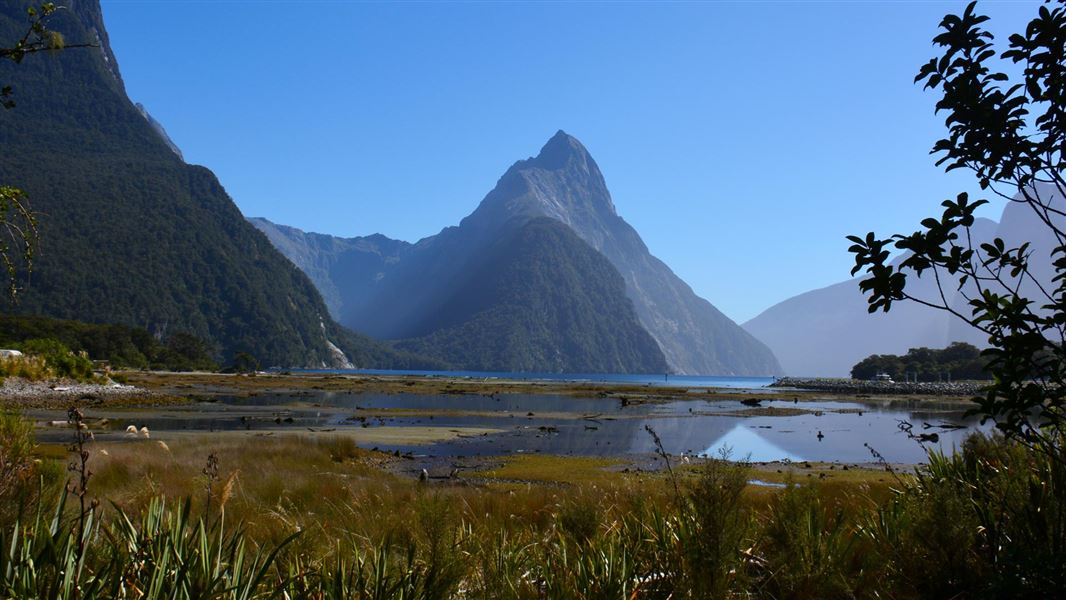- Enjoy magnificent scenery on Milford Road - the U-shaped valleys open out to sheer, rugged basins and peaks. Once through the Homer Tunnel, you will see grand views down to sea level.
- Iconic Mitre Peak is one of the most recognised (and photographed) peaks in the world, with its sheer rock walls rising 1,692 m directly from the water. Enjoy some of the best views of Mitre Peak from the Milford Sound Foreshore Walk.
- Walk the world famous Milford Track, or a half day walk on the Routeburn Track from The Divide, to enjoy unbelievable views from Key Summit.
- Mountain climbing peaks - the Darran Mountains, accessed via the Gertrude Saddle and the Hollyford Valley, are well known for their exciting mountain climbing opportunities.
- Piopiotahi (Milford Sound) Marine Reserve is one of 10 marine reserves in Fiordland.
- This is one of the wettest areas in the country (up to 7 m of rain per year) and has an incredibly rugged landscape carved by glacial ice. Under the water the mountains continue to depths of up to 265 m.
- Tsunami risk at Milford Sound – a big earthquake could trigger a large tsunami in Piopiotahi Milford Sound. The 'Know before you go' section of this page has more information.
The Milford Road (part of SH94) starts from Te Anau, and heads north towards Milford Sound/Piopiotahi (120 km).
The nearest town with facilities is Te Anau, and there are limited facilities at Milford Sound/Piopiotahi.
Allow about 2 hours to drive the whole Milford Road, without stops. There are many enjoyable short walks and viewpoints along the way, as well as DOC campsites should you wish to take more time.
Book Milford Road campsites online before your visit
Fibre internet has been installed along the Milford Road but mobile phone reception is limited. These Milford Road stopping points and campsites now have reception:
- Te Anau Downs
- Totara Campsite
- The Divide
- Milford Sound
Milford Road travel advice
See Milford Road tips for drivers to find out about planning your trip up the Milford Road and to Milford Sound/Piopiotahi, how to get there, tips and a map for your drive, information on winter conditions and more.
Expect road closures and traffic delays due to weather conditions, rock falls, and snow/avalanche in winter.
Freedom camping (within 200 m of the road) is not allowed on the Milford Road. Find out more about freedom camping in New Zealand.
Weather forecast
All drone use must be authorised by DOC
You must have a permit to fly a drone on public conservation land.
Visit our Drone use on conservation land page for more information.
Tsunami risk at Milford Sound
There can be large tsunamis in Piopiotahi Milford Sound.
A big earthquake could cause a landslide into the fiord, quickly creating a huge tsunami. This would leave little time and limited options for people to escape.
If there is strong earthquake shaking, unusual ocean behaviour or noise, move to high ground and/or inland. Do not wait for official warnings.
Enjoy plants, animals and geology along the Milford Road and in Milford Sound/Piopiotahi. Read about nature and conservation in Milford Road/Milford Sound area.
Early Māori gathered greenstone here
There are two principal trails linking the Fiordland coast with the rest of Te Wai Pounamu (the South Island).
A sea route was the main route used by early Māori to transport the kokotakiwai (greenstone) to Murihiku (Southland). The inland route lay over what is now known as the Milford Track, over Omanui (McKinnon Pass), down the Waitawai (Clinton River) to the head of Te Ana-au (Lake Te Anau) then towards Te Ara a Kiwa (Foveaux Strait).
The Māori name for Milford Sound is Piopiotahi, after the native thrush - piopio - now probably extinct.
Permanent Māori settlements were located in the Hollyford Valley and around lakes Manapouri and Te Anau, linked by well-worn routes through territory rich with eels and forest resources.
The first European settlers, explorers and tourism
Milford Sound was named by a Welsh sealing captain John Grono after his birth place, Milford Haven.
Donald Sutherland, a Scottish sealer, soldier and gold prospector, was the first European resident. When he saw Milford Sound for the first time, he declared, “If ever I come to anchor it will be here.” He kept his word and in 1878 built three thatched huts, which he called the City of Milford. A fiord and waterfall are named after him.
A dozen years later, the Milford Track was cut between Te Anau and Milford by Sutherland and Quintin Mackinnon, establishing a land link with the interior and a tourist route. Sutherland’s wife Elizabeth opened a boarding house for “asphalters” - cityfolk who came to enjoy Fiordland’s grandeur.
In 1889 William Homer discovered the saddle now named after him. The section of road from Te Anau to the Divide was completed by government work scheme gangs in the 1930s. Work on the Homer Tunnel began in 1935 but difficult conditions and interruption by the Second World War delayed its completion until 1954.
Te Rua-o-te-moko/Fiordland National Park Visitor Centre
| Phone: | +64 3 249 7924 |
| Email: | fiordlandvc@doc.govt.nz |
| Address: | 1 Lakefront Drive Te Anau 9600 |
| Hours: | Visitor centre hours and services |
